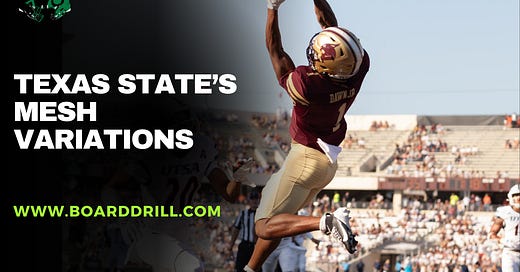Texas State's Mesh Variations
Earlier this week, we took a deep dive into Texas State’s Choice Switch concept and how they use it to stress defenses. Now, we’re turning our attention to another key piece of their passing game, the Mesh concept and its variations. As we broke down the Bobcats’ film, Mesh consistently stood out as a go-to answer against multiple coverages. In this article, we’ll break down the different ways Texas State runs Mesh and how they adjust it based on the defenses they faced throughout the season.
Mesh-Rail versus Fire Zone Pressure
The first variation we’re looking at is Mesh-Rail out of a 2x2 compressed set, with the Bobcats adding a late backfield adjustment just before the snap. The defense brings a five-man Fire Zone pressure behind a 3-under, 3-deep coverage shell. The underneath defenders react by matching to their zones, one carrying the field-side crosser, another working to the rail route. That leaves the boundary crosser uncovered, creating an easy pitch-and-catch for a solid gain.
Traditional Mesh versus 6-Man “Hot” Pressure
"Hot" pressures are all about disruption and are designed to sack the quarterback or force a hurried throw. Against this 6-man pressure, the Bobcats’ QB finds just enough time to deliver the ball to the uncovered crosser. With one hot defender matching the running back and another matching the spot route, the mesh routes come wide open, giving the quarterback multiple options. A great example of how Mesh provides built-in answers against heavy pressure.
Mesh-Rail versus Cover 3
Texas State does a great job here of attacking the soft spot behind the hook defenders in Cover 3. The mesh routes serve as natural eye-candy, holding the underneath defenders just long enough for the spot route to settle into open space. The quarterback recognizes it immediately and delivers a strike for a solid gain. A key coaching point, the spot route must work to 10 yards over the ball to maximize spacing and timing within the concept.
Mesh Return versus Cover 1
Mesh is already a Cover 1 beater, but when defenders are aggressively driving on their assignments, Mesh-Return becomes a perfect counter. Instead of continuing across the field, both mesh receivers sell the drag before snapping back out toward the sideline. This punishes defenders who are sprinting to stay in phase, forcing them to overrun the route and leaving easy separation for the offense.
Mesh-Rail in Low Red Zone
Texas State dials up a creative twist on Mesh-Rail in the low red zone, starting in Trips FIB (Formation Into the Boundary) before motioning a receiver into the backfield. That motioned player then runs the Rail route, immediately drawing two defenders. With the Rail occupying multiple defenders, the boundary crosser wins his 1-on-1 matchup, forcing the defender to panic and commit a pass interference. A well-designed variation that creates stress on the defense in a compressed area of the field.
Mesh-Traffic in Low Red Zone
Mesh-Traffic has become one of the more popular variations of the concept, especially after Michigan used it effectively during their 2023 championship run. Typically, the running back releases through the line of scrimmage, creating another layer of conflict for defenders. However, in this instance, the defense brings pressure, forcing the back to adjust and work off the edge instead. Despite the defense playing it well, Mesh-Traffic remains a tough concept to defend, making it a variation worth highlighting.
Conclusion
Texas State’s Mesh concept and its variations are a key part of their passing game, providing answers against multiple coverages. Whether it’s Mesh-Rail stretching the field, Mesh-Return countering aggressive man coverage, or Mesh-Traffic creating natural interference in tight spaces, the Bobcats consistently find ways to put stress on defenses. These adjustments make Mesh one of the most versatile tools in their playbook, allowing them to attack both pressure and coverage-based schemes with built-in solutions.
Want to see these concepts in action? Check out the full cutups in the Related Articles section below.





